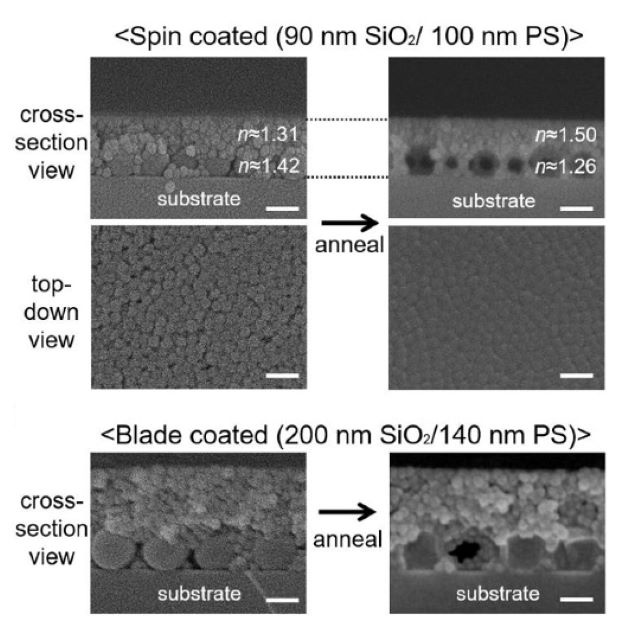A scalable heterogeneous nanoparticle film with controllable manufacturing methods with tunable properties that could be useful for a variety of applications.
Problem:
Current techniques for manufacturing polymer-infiltrated nanoparticle films (PINFs) include immersion in polymer melts, capillary rise infiltration, and solvent-driven infiltration. These methods only produce homogenous PINFs that have a uniform composition and structure throughout the thickness. Heterostructured PINFs with varying structures would be useful for certain applications including drug delivery, membrane separation, and photonics, but there is a lack of scalable and controllable methods to produce such PINFs.
Solution:
The inventors developed a scalable and controllable method to produce tunable heterostructued PINFs with a high-volume fraction of nanoparticles. The thickness and porosity of these PINFs can be modulated, creating films with varying physical and optical properties that can be customized for different applications. Additionally, the method does not use organic solvents, making it eco-friendly.
Technology:
A layer of silicon dioxide (SiO2) nanoparticles is spin-coated onto a layer of larger polystyrene nanoparticles. These dispersions may also be mixed and blade-coated in one step for better manufacture scaling. The bilayer is heated above polystyrene’s glass temperature (100⁰C), and the polystyrene particles melt and wick into the SiO2 layer. The space occupied by the polystyrene nanoparticles is left void of SiO2 nanoparticles. The film’s refractive index can be tuned by changing the relative volume of inorganic nanoparticles, and therefore the relative pore size. Films of alternating refractive indices can be stacked to form a Bragg reflector.
Advantages:
- Greater than 60% volume fraction of nanoparticles
- Allows for production of nanoparticle films specific to different applications
- Eco-friendly option that eliminates need for organic solvents

The figure shows SEM images before and after nanocomposite annealing. SiO2 nanoparticles are layered on polystyrene particles, which melt and form a matrix upon solvent-driven annealing. This leaves the space previously occupied by SiO2 unoccupied. The films can be produced by using either a blade or a spinner to coat the substrate.
Case ID:
20-9443-tpNCS
Web Published:
5/16/2024
Patent Information:
| App Type |
Country |
Serial No. |
Patent No. |
File Date |
Issued Date |
Expire Date |